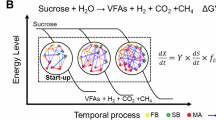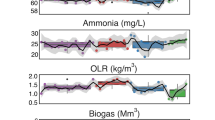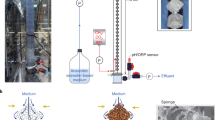Abstract
Ecogenomic investigation of a methanogenic bioreactor degrading terephthalate (TA) allowed elucidation of complex synergistic networks of uncultivated microorganisms, including those from candidate phyla with no cultivated representatives. Our previous metagenomic investigation proposed that Pelotomaculum and methanogens may interact with uncultivated organisms to degrade TA; however, many members of the community remained unaddressed because of past technological limitations. In further pursuit, this study employed state-of-the-art omics tools to generate draft genomes and transcriptomes for uncultivated organisms spanning 15 phyla and reports the first genomic insight into candidate phyla Atribacteria, Hydrogenedentes and Marinimicrobia in methanogenic environments. Metabolic reconstruction revealed that these organisms perform fermentative, syntrophic and acetogenic catabolism facilitated by energy conservation revolving around H2 metabolism. Several of these organisms could degrade TA catabolism by-products (acetate, butyrate and H2) and syntrophically support Pelotomaculum. Other taxa could scavenge anabolic products (protein and lipids) presumably derived from detrital biomass produced by the TA-degrading community. The protein scavengers expressed complementary metabolic pathways indicating syntrophic and fermentative step-wise protein degradation through amino acids, branched-chain fatty acids and propionate. Thus, the uncultivated organisms may interact to form an intricate syntrophy-supported food web with Pelotomaculum and methanogens to metabolize catabolic by-products and detritus, whereby facilitating holistic TA mineralization to CO2 and CH4.
Similar content being viewed by others
Log in or create a free account to read this content
Gain free access to this article, as well as selected content from this journal and more on nature.com
or
References
Baena S, Fardeau ML, Labat M, Ollivier B, Thomas P, Garcia JL et al. (1998). Aminobacterium colombiense gen. nov. sp. nov., an amino acid-degrading anaerobe isolated from anaerobic sludge. Anaerobe 4: 241–250.
Balk M, Weijma J, Stams AJ . (2002). Thermotoga lettingae sp. nov., a novel thermophilic, methanol-degrading bacterium isolated from a thermophilic anaerobic reactor. Int J Syst Evol Microbiol 52: 1361–1368.
Buckel W, Thauer RK . (2013). Energy conservation via electron bifurcating ferredoxin reduction and proton/Na(+) translocating ferredoxin oxidation. Biochim Biophys Acta 1827: 94–113.
Calusinska M, Happe T, Joris B, Wilmotte A . (2010). The surprising diversity of clostridial hydrogenases: a comparative genomic perspective. Microbiology 156: 1575–1588.
Camacho C, Coulouris G, Avagyan V, Ma N, Papadopoulos J, Bealer K et al. (2009). BLAST+: architecture and applications. BMC Bioinformatics 10: 421.
Chen CL, Macarie H, Ramirez I, Olmos A, Ong SL, Monroy O et al. (2004). Microbial community structure in a thermophilic anaerobic hybrid reactor degrading terephthalate. Microbiology 150: 3429–3440.
Chouari R, Le Paslier D, Dauga C, Daegelen P, Weissenbach J, Sghir A . (2005). Novel major bacterial candidate division within a municipal anaerobic sludge digester. Appl Environ Microbiol 71: 2145–2153.
Conrad RS, Massey LK, Sokatch JR . (1974). D- and L-isoleucine metabolism and regulation of their pathways in Pseudomonas putida. J Bacteriol 118: 103–111.
Dubourguier HC, Samain E, Prensier G, Albagnac G . (1986). Characterization of 2 strains of Pelobacter carbinolicus isolated from anaerobic digesters. Arch Microbiol 145: 248–253.
Fardeau ML, Patel BK, Magot M, Ollivier B . (1997). Utilization of serine, leucine, isoleucine, and valine by Thermoanaerobacter brockii in the presence of thiosulfate or Methanobacterium sp. as electron acceptors. Anaerobe 3: 405–410.
Frias-Lopez J, Shi Y, Tyson GW, Coleman ML, Schuster SC, Chisholm SW et al. (2008). Microbial community gene expression in ocean surface waters. Proc Natl Acad Sci USA 105: 3805–3810.
Glockner J, Kube M, Shrestha PM, Weber M, Glockner FO, Reinhardt R et al. (2010). Phylogenetic diversity and metagenomics of candidate division OP3. Environ Microbiol 12: 1218–1229.
Griebler C, Lueders T . (2009). Microbial biodiversity in groundwater ecosystems. Freshw Biol 54: 649–677.
Harmsen HJM, Van Kuijk BLM, Plugge CM, Akkermans ADL, De Vos WM, Stams AJM . (1998). Syntrophobacter fumaroxidans sp. nov., a syntrophic propionate-degrading sulfate-reducing bacterium. Int J Syst Bacteriol 48: 1383–1387.
Huang H, Wang S, Moll J, Thauer RK . (2012). Electron bifurcation involved in the energy metabolism of the acetogenic bacterium Moorella thermoacetica growing on glucose or H2 plus CO2. J Bacteriol 194: 3689–3699.
Hugenholtz J, Ljungdahl LG . (1989). Electron transport and electrochemical proton gradient in membrane vesicles of Clostridium thermoautotrophicum. J Bacteriol 171: 2873–2875.
Juottonen H, Galand PE, Tuittila ES, Laine J, Fritze H, Yrjala K . (2005). Methanogen communities and Bacteria along an ecohydrological gradient in a northern raised bog complex. Environ Microbiol 7: 1547–1557.
Kaster AK, Moll J, Parey K, Thauer RK . (2011). Coupling of ferredoxin and heterodisulfide reduction via electron bifurcation in hydrogenotrophic methanogenic archaea. Proc Natl Acad Sci USA 108: 2981–2986.
Kim M, Morrison M, Yu Z . (2011). Status of the phylogenetic diversity census of ruminal microbiomes. FEMS Microbiol Ecol 76: 49–63.
Kong YH, Teather R, Forster R . (2010). Composition, spatial distribution, and diversity of the bacterial communities in the rumen of cows fed different forages. FEMS Microbiol Ecol 74: 612–622.
Kosaka T, Kato S, Shimoyama T, Ishii S, Abe T, Watanabe K . (2008). The genome of Pelotomaculum thermopropionicum reveals niche-associated evolution in anaerobic microbiota. Genome Res 18: 442–448.
Lykidis A, Chen CL, Tringe SG, McHardy AC, Copeland A, Kyrpides NC et al. (2011). Multiple syntrophic interactions in a terephthalate-degrading methanogenic consortium. ISME J 5: 122–130.
Marcy Y, Ouverney C, Bik EM, Loesekann T, Ivanova N, Martin HG et al. (2007). Dissecting biological "dark matter" with single-cell genetic analysis of rare and uncultivated TM7 microbes from the human mouth. Proc Natl Acad Sci USA 104: 11889–11894.
Matthies C, Schink B . (1992). Reciprocal isomerization of butyrate and isobutyrate by the strictly anaerobic bacterium strain WoG13 and methanogenic isobutyrate degradation by a defined triculture. Appl Environ Microbiol 58: 1435–1439.
McInerney MJ, Rohlin L, Mouttaki H, Kim U, Krupp RS, Rios-Hernandez L et al. (2007). The genome of Syntrophus aciditrophicus: Life at the thermodynamic limit of microbial growth. Proc Natl Acad Sci USA 104: 7600–7605.
McInerney MJ, Sieber JR, Gunsalus RP . (2009). Syntrophy in anaerobic global carbon cycles. Curr Opin Biotechnol 20: 623–632.
Miller CS, Baker BJ, Thomas BC, Singer SW, Banfield JF . (2011). EMIRGE: reconstruction of full-length ribosomal genes from microbial community short read sequencing data. Genome Biology 12: R44.
Mountfort DO, Brulla WJ, Krumholz LR, Bryant MP . (1984). Syntrophus buswellii gen. nov., sp. nov.: a benzoate catabolizer from methanogenic ecosystems. Int J Syst Bacteriol 34: 216–217.
Muller B, Sun L, Schnurer A . (2013). First insights into the syntrophic acetate-oxidizing bacteria—a genetic study. Microbiologyopen 2: 35–53.
Muller V, Imkamp F, Biegel E, Schmidt S, Dilling S . (2008). Discovery of a ferredoxin:NAD+-oxidoreductase (Rnf) in Acetobacterium woodii: a novel potential coupling site in acetogens. Ann NY Acad Sci 1125: 137–146.
Narihiro T, Nobu MK, Kim NK, Kamagata Y, Liu WT . (2014). The nexus of syntrophy-associated microbiota in anaerobic digestion revealed by long-term enrichment and community survey. Environ Microbiol e-pub ahead of print 4 September 2014; doi:10.1111/1462-2920.12616.
Nelson MC, Morrison M, Yu Z . (2011). A meta-analysis of the microbial diversity observed in anaerobic digesters. Bioresour Technol 102: 3730–3739.
Nemergut DR, Townsend AR, Sattin SR, Freeman KR, Fierer N, Neff JC et al. (2008). The effects of chronic nitrogen fertilization on alpine tundra soil microbial communities: implications for carbon and nitrogen cycling. Environ Microbiol 10: 3093–3105.
Nobu MK, Narihiro T, Hideyuki T, Qiu YL, Sekiguchi Y, Woyke T et al. (2014). The genome of Syntrophorhabdus aromaticivorans strain UI provides new insights for syntrophic aromatic compound metabolism and electron flow. Environ Microbiol e-pub ahead of print 3 March 2014; doi:10.1111/1462-2920.12444.
Pati A, Heath LS, Kyrpides NC, Ivanova N . (2011). ClaMS: a classifier for metagenomic sequences. Stand Genomic Sci 5: 248–253.
Patil KR, Roune L, McHardy AC . (2012). The PhyloPythiaS web server for taxonomic assignment of metagenome sequences. PLoS One 7: e38581.
Plugge CM, Balk M, Zoetendal EG, Stams AJ . (2002). Gelria glutamica gen. nov., sp. nov., a thermophilic, obligately syntrophic, glutamate-degrading anaerobe. Int J Syst Evol Microbiol 52: 401–407.
Qatibi AI, Cayol JL, Garcia JL . (1991). Glycerol and propanediols degradation by Desulfovibrio alcoholovorans in pure culture in the presence of sulfate, or in syntrophic association with Methanospirillum hungatei. FEMS Microbiol Lett 85: 233–240.
Qiu YL, Sekiguchi Y, Imachi H, Kamagata Y, Tseng IC, Cheng SS et al. (2003). Sporotomaculum syntrophicum sp. nov., a novel anaerobic, syntrophic benzoate-degrading bacterium isolated from methanogenic sludge treating wastewater from terephthalate manufacturing. Arch Microbiol 179: 457–457.
Qiu YL, Sekiguchi Y, Imachi H, Kamagata Y, Tseng IC, Cheng SS et al. (2004). Identification and isolation of anaerobic, syntrophic phthalate isomer-degrading microbes from methanogenic sludges treating wastewater from terephthalate manufacturing. Appl Environ Microbiol 70: 1617–1626.
Qiu YL, Sekiguchi Y, Hanada S, Imachi H, Tseng IC, Cheng SS et al. (2006). Pelotomaculum terephthalicum sp. nov. and Pelotomaculum isophthalicum sp. nov.: two anaerobic bacteria that degrade phthalate isomers in syntrophic association with hydrogenotrophic methanogens. Arch Microbiol 185: 172–182.
Qiu YL, Hanada S, Ohashi A, Harada H, Kamagata Y, Sekiguchi Y . (2008). Syntrophorhabdus aromaticivorans gen. nov., sp nov., the first cultured anaerobe capable of degrading phenol to acetate in obligate syntrophic associations with a hydrogenotrophic methanogen. Appl Environ Microbiol 74: 2051–2058.
Rinke C, Schwientek P, Sczyrba A, Ivanova NN, Anderson IJ, Cheng JF et al. (2013). Insights into the phylogeny and coding potential of microbial dark matter. Nature 499: 431–437.
Riviere D, Desvignes V, Pelletier E, Chaussonnerie S, Guermazi S, Weissenbach J et al. (2009). Towards the definition of a core of microorganisms involved in anaerobic digestion of sludge. ISME J 3: 700–714.
Rotaru A-E, Shrestha PM, Liu F, Ueki T, Nevin K, Summers ZM et al. (2012). Interspecies electron transfer via hydrogen and formate rather than direct electrical connections in cocultures of Pelobacter carbinolicus. Appl Environ Microbiol 78: 7645–7651.
Schink B . (1997). Energetics of syntrophic cooperation in methanogenic degradation. Microbiol Mol Biol Rev 61: 262–280.
Schink B, Stams AJM . (2006) Syntrophism among Prokaryotes. Springer: New York.
Schink B, Stams AJM . (2013). Syntrophism among Prokaryotes. In: Rosenberg E, DeLong E, Lory S, Stackebrandt E, Thompson F (eds) The Prokaryotes. Springer: Berlin Heidelberg, pp 471–493.
Schmidt S, Biegel E, Muller V . (2009). The ins and outs of Na(+) bioenergetics in Acetobacterium woodii. Biochim Biophys Acta 1787: 691–696.
Sieber JR, Sims DR, Han C, Kim E, Lykidis A, Lapidus AL et al. (2010). The genome of Syntrophomonas wolfei: new insights into syntrophic metabolism and biohydrogen production. Environ Microbiol 12: 2289–2301.
Sieber JR, McInerney MJ, Gunsalus RP . (2012). Genomic insights into syntrophy: the paradigm for anaerobic metabolic cooperation. Annu Rev Microbiol 66: 429–452.
Sieber JR, Le HM, McInerney MJ . (2014). The importance of hydrogen and formate transfer for syntrophic fatty, aromatic and alicyclic metabolism. Environ Microbiol 16: 177–188.
Speece RE . (1996) Anaerobic Biotechnology for Industrial Wastewaters. Archae Press: Nashville, TN.
Stieb M, Schink B . (1986). Anaerobic degradation of isovalerate by a defined methanogenic coculture. Arch Microbiol 144: 291–295.
Strous M, Kraft B, Bisdorf R, Tegetmeyer HE . (2012). The binning of metagenomic contigs for microbial physiology of mixed cultures. Front Microbiol 3: 410.
Taylor MB . (2005). TOPCAT & STIL: Starlink Table/VOTable Processing Software. ASP Conf Ser 347: ADASS XIV, 29.
Thauer RK, Jungermann K, Decker K . (1977). Energy-conservation in chemotrophic anaerobic bacteria. Bacteriol Rev 41: 100–180.
Thauer RK, Kaster AK, Seedorf H, Buckel W, Hedderich R . (2008). Methanogenic archaea: ecologically relevant differences in energy conservation. Nat Rev Microbiol 6: 579–591.
Tremblay PL, Zhang T, Dar SA, Leang C, Lovley DR . (2012). The Rnf complex of Clostridium ljungdahlii is a proton-translocating ferredoxin:NAD+ oxidoreductase essential for autotrophic growth. MBio 4: e00406–e00412.
Tyson GW, Chapman J, Hugenholtz P, Allen EE, Ram RJ, Richardson PM et al. (2004). Community structure and metabolism through reconstruction of microbial genomes from the environment. Nature 428: 37–43.
Wang S, Huang H, Kahnt J, Thauer RK . (2013). Clostridium acidurici electron-bifurcating formate dehydrogenase. Appl Environ Microbiol 79: 6176–6179.
Wildenauer FX, Winter J . (1986). Fermentation of isoleucine and arginine by pure and syntrophic cultures of Clostridium sporogenes. FEMS Microbiol Lett 38: 373–379.
Wu JH, Liu WT, Tseng IC, Cheng SS . (2001). Characterization of microbial consortia in a terephthalate-degrading anaerobic granular sludge system. Microbiology-Uk 147: 373–382.
Wu JH, Wu FY, Chuang HP, Chen WY, Huang HJ, Chen SH et al. (2013). Community and proteomic analysis of methanogenic consortia degrading terephthalate. Appl Environ Microbiol 79: 105–112.
Yamada T, Sekiguchi Y . (2009). Cultivation of uncultured Chloroflexi subphyla: significance and ecophysiology of formary uncultured Chloroflexi 'subphylum I' with natural and biotechnological relevance. Microbes Environ 24: 205–216.
Acknowledgements
We acknowledge Peiying Hong, Xianzheng Li and Hideyuki Tamaki for sample preparation. We thank Bernhard Schink for etymological advice on Prokaryote Candidatus nomenclature. We also thank reviewers for invaluable input. The work conducted by the US Department of Energy Joint Genome Institute is supported by the US Department of Energy Office of Science under Contract No. DE-AC02-05CH11231. This work is also supported by the US Department of Energy under Award DE-SC0006771 to the University of Illinois, Urbana–Champaign, and a grant from the Energy Biosciences Institute (EBI) at the University of Illinois Urbana-Champaign (UIUC) to WTL.
Author information
Authors and Affiliations
Corresponding author
Ethics declarations
Competing interests
The authors declare no conflict of interest.
Additional information
Supplementary Information accompanies this paper on The ISME Journal website
Supplementary information
Rights and permissions
About this article
Cite this article
Nobu, M., Narihiro, T., Rinke, C. et al. Microbial dark matter ecogenomics reveals complex synergistic networks in a methanogenic bioreactor. ISME J 9, 1710–1722 (2015). https://doi.org/10.1038/ismej.2014.256
Received:
Revised:
Accepted:
Published:
Issue date:
DOI: https://doi.org/10.1038/ismej.2014.256
This article is cited by
-
Unique H2-utilizing lithotrophy in serpentinite-hosted systems
The ISME Journal (2023)
-
Functional and molecular approaches for studying and controlling microbial communities in anaerobic digestion of organic waste: a review
Reviews in Environmental Science and Bio/Technology (2023)
-
Methanogenesis in biogas reactors under inhibitory ammonia concentration requires community-wide tolerance
Applied Microbiology and Biotechnology (2023)
-
Anaerobic microbial cocktail of lignocellulolytic fungi and bacteria with methanogens for boosting methane production from unpretreated rice straw
Bioprocess and Biosystems Engineering (2023)
-
Reduce methane emission from rice paddies by man-made aerenchymatous tissues
Carbon Research (2023)



